Brand fights 'performance think' on the beaches: Peter Field, Karen Nelson-Field, Orlando Wood unpack data to prove ad effectiveness, mental availability, SOV rules failing, machine measurement damaging MMM, attribution
An Mi3 editorial series brought to you by
LinkedIn


Peter Field, Karen Nelson-Field, Orlando Wood: Robust data from IPA Effectiveness bank and five years of attention studies underlines how deeply "performance think" is damaging brands, growth, profit.
At Cannes, Peter Field, Karen Nelson-Field and Orlando Wood spearheaded a three-pronged, data-driven counteroffensive on overweight performance budgets at the expense of brand. Presenting 20 years of IPA and five years of Amplified Intelligence data, the three outlined a 10-15 year decline in brands building mental availability and advertising effectiveness and the erosion of marketing laws that used to reliably help brands grow. Marketer heads have been simultaneously turned by metrics such as viewability, yet the vast majority deliver "zero human attention", per Nelson-Field. Meanwhile, compound data errors – mistaking device data for human data – have flow on effects that risk blowing holes in media mix modelling. But they also presented some simple solutions.
What you need to know:
- Marketers can no longer be sure that ESOV (growing by investing in higher share of voice than marketshare) is working because market failing to recognise all impressions are not equal and going too hard on performance over brand building.
- Relationship between share of voice and mental availability peaked circa 2008, now “far less reliable” marketing law, according to multiyear IPA data presented by Peter Field at Cannes.
- Ad effectiveness also in decline due to “performance think” permeating marketing industry.
- Karen Nelson-Field said ad industry and its supply chain are measuring the wrong things – inward facing data (meta/device) instead of outward facing data, i.e. people.
- Compound data errors risk knock-on effects, leading marketers to over-value viewability and making media mix modelling results questionable.
- System1’s Orlando Wood mapped left-brain narrow ads versus broad-beam right brain ads across IPA database – and found right brain campaigns generated brand, sales and profit gain.
When you rely on something that’s not fed with human data, then you are essentially compounding the error in the machine learning model. Think about the knock-on effects.
Amid the tech tents and digital platforms staking out Cannes, a line in the sand has been drawn. The old school brand marketers are digging in to counter “more than a decade” of platform-fuelled narrative that performance trumps brand in driving growth and profit, according to ad effectiveness luminary Peter Field – with marketing rules and ad effectiveness crumbling as a result.
Using multiyear IPA Effectiveness data and attention data, the brand camp are ratcheting up pressure on the performance marketing camp to return fire with data of their own that credibly and robustly defends the position that short-term, tactical performance marketing should be prioritised by marketers and business leaders.
While all three reiterated that performance marketing has its place, they say it has been overweighted to the point of damaging brands, profits and growth.
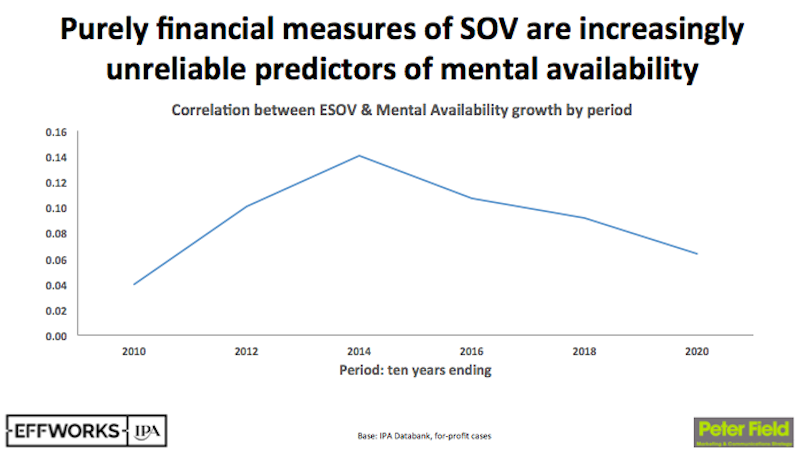
More worryingly, he said brand campaigns, “just simply don't build mental availability like they used to,” with positive impacts peaking in around 2008 and declining since, per IPA data. “And we see a worrying dollar for dollar drop in effectiveness that comes off the back of that.”
The upshot is that “it is getting less likely and much less predictable that a dollar spent will build mental availability and so drive growth,” said Field.
Field said there is a direct relationship between SOV and mental availability – the ability to strengthen the brand in people’s minds.
IPA data suggests that “the relationship peaked in about 2007/08 [when it was] easily significant at the 99 per cent level,” said Field. “You could bank on it. Now it has lost a great deal of significance. It is nowhere near as reliable as it once was.”
He said ad effectiveness has also “fallen way down from the peak … in the early part of the millennium. Since then … ‘performance think’ has damaged the whole picture,” said Field.
“We need to remember the lessons that we once followed.”
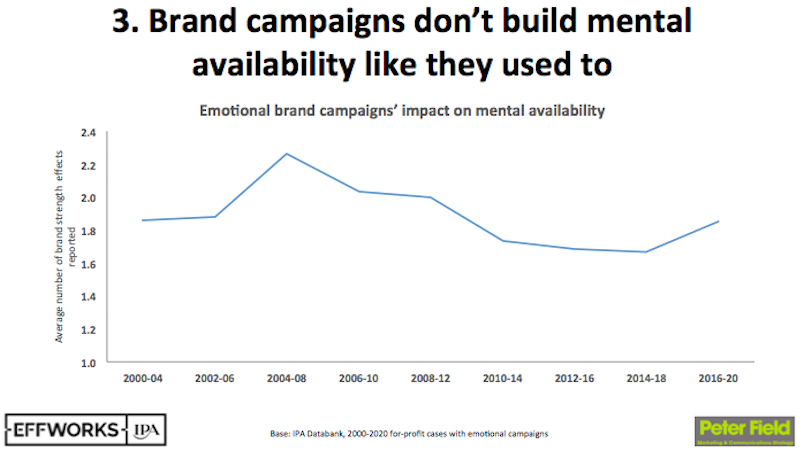
Measure people data, not device data
Karen Nelson-Field said the reason that relationships between share of voice and mental availability are fracturing is because the ad industry and its supply chain are measuring the wrong things – inward facing (meta/device) data instead of outward facing data, i.e. people.
She warned the effects go beyond ad effectiveness and brand building and into measurement, media mix modelling and attribution – because the media supply chain is compounding error on top of error.
The upshot is that marketers are basing investments based upon highly questionable results.
“We stopped measuring humans and we started measuring meta data and device data. The problem is, that makes the assumption that device metadata is an accurate predictor of human behaviour – it is… and it isn’t,” said Nelson Field. “But when you rely on something that’s not fed with human data, then you are essentially compounding the error in the machine learning model.”
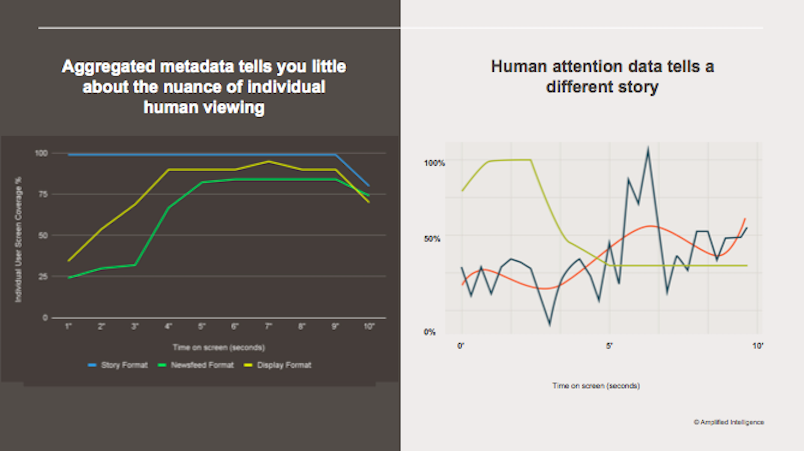
Nelson-Field said such compound errors have led marketers to over-value metrics such as viewability, where the vast majority of dollars are arguably being wasted, she suggested.
“We know that about 70 per cent of the ads you buy using MRC accredited metrics [viewability] get zero attention from humans. Have a think about that,” said Nelson-Field. “We’ve been doing this for five years, testing across eleven countries, and hundreds of thousands of data units.”
Such measurement errors are hard to fix, she said, because they are inconsistent across platforms and formats.
“So if you don't understand [these differences] then you can't normalise for them. Inward facing data doesn't capture this at all, which is why we should continue to think about measuring outward, not just inwards.”
Perverse outcomes, MMM threatened
While the ad industry is attempting to overlay measure onto viewability to improve the metric, Nelson Field suggests efforts to date are “ill-fitting Band Aids” that risk perverse outcomes.
“When there is inequity across impressions, it has flow-on effects. It has an impact on planning and buying media but also any system model – any kind of MMM [media mix modelling] that requires equitable impressions will fail. Think about the scale of that flow-on effect.”
She said share of voice/share of market is another classic example. “When a critical input variable fails, the accuracy of the output is anyone’s guess … This is why that relationship is failing and it all stems from the same time – when we started to measure inwards, not outwards.”
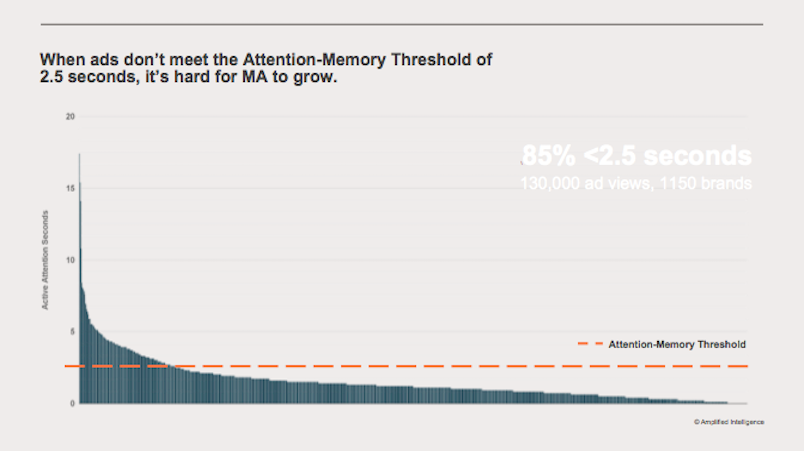
Attention memory threshold: 2 seconds won’t cut it
Ads need to hold attention for a minimum of 2.5 seconds to start to build memory structures, "and we see that quite consistently,” said Nelson Field. “In the last set of data we collected, 130,000 ads, 85 per cent of them were sitting under that threshold. That’s not to suggest that performance marketing is not valuable … but if you want to grow your brand, you need to hit the threshold.”
By eschewing higher attention channels and relying on low attention channels, Nelson-Field said brands compound Andrew Ehrenberg's double jeopardy rule – by leaving competitors that recognise the importance of mental availability a free run, and therefore higher share of voice, in those channels.
Creativity – or good ads alone – won’t fix it, she warned, because a great ad can only perform a limited function in a low attention environment. I.e. if people are not paying any attention, it doesn’t matter how good the ad is.
Left brain/right brain imbalance
But bad ads in high attention channels are also likely a waste of money – and the effects of advertising short-termism are increasingly reflected in the ads brands and agencies are now making: short, narrow, product-focused ads with more of a hard sell then creative nuance, according to System1’s Orlando Wood.
He thinks the marketing supply chain has swung too far towards the left-brain hemisphere, which processes narrow information, at the expense of appealing to the right brain, which is broader, more empathetic and “more open to novelty and interpretation… and which passes anything of interest over to the left.”
Wood said the firm’s data suggests the result is that campaigns are now chasing the least effective strategies when it comes to building brands.
“Over the last 15 years we have been losing broad beam attention … and spending more time on narrow beam attention, in culture, society and advertising style,” said Wood.
“The most effective features [that build a connection with people, and therefore brands and ad effectiveness] are disappearing, the least effective are becoming more common.”
He said the tipping point came “in around 2006 … with a wholesale swing away from whole brain or even slightly right brain advertising towards left-brain advertising in the ascendance and dominance”.
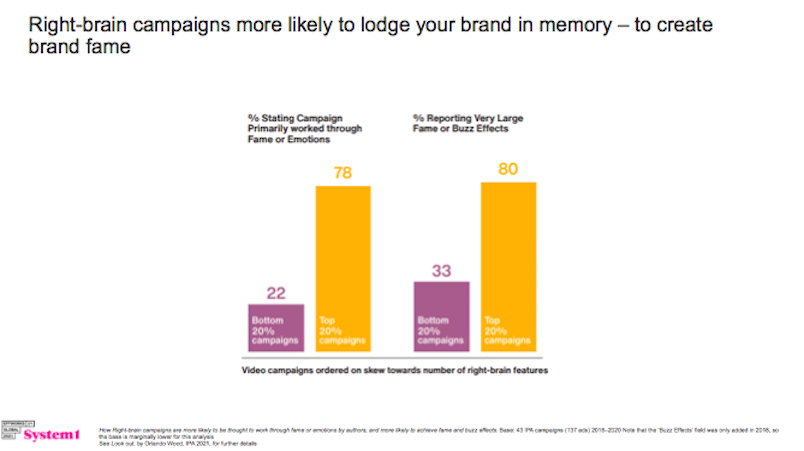
Working with Peter Field, Wood used the IPA’s database to map and contrast left brain and right brain across a sample of campaigns.
“We found that it was the right brain campaigns that generated sales effects – profit gain, share gain, large, lasting effects. And they do it because they're much better able to lodge the brand in long term memory, much better able to make your brand leap to mind before any other,” said Wood.
“The problem is that this creative dividend is lost on poor attention media. So we might conclude that when it comes to creative development … we need advertising with wit and charm, advertising with human vitality, advertising that entertains … on attention rich media.”
